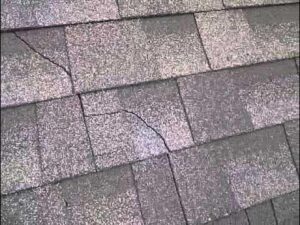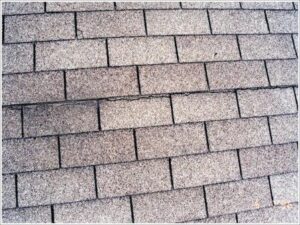Thermal Splitting (Cracked Shingles)



Thermal splitting is a common problem that occurs when asphalt shingles split due to temperature changes:
Cause: When shingles expand and contract, the joints between them change size, which can create stress on the shingles. The top layer of shingles expands faster than the base layer because it receives more heat from the sun.
Appearance: Thermal splitting is characterized by long cracks that run across the surface of the shingle.
Effects: Thermal splitting can compromise the structural integrity of your roof, leading to water leaks and reduced wind resistance.
Factors that can contribute: Thermal splitting can be caused by poor product durability, uneven heat distribution, and inadequate tear resistance.
How to avoid: Thermal splitting can be avoided by using high quality materials and properly spacing them to allow for expansion and contraction.
Shingle granule loss is when the protective granules that cover asphalt shingles start to wear away or detach. Granules are important because they protect shingles from UV rays, weathering, and impact damage. When granules are lost, the underlying asphalt can be exposed, which can compromise the shingle’s integrity.
Here are some signs of shingle granule loss:
- Gutters
- If you notice a significant number of granules in your gutters or downspouts, it could be a sign of granule loss.
- Shingles
- If you see bald or shiny patches on your shingles, or if they appear discolored or faded, it could be a sign of granule loss.
Granule loss is normal and expected as a roof ages, BUT there are other causes that can lead to quicker loss, including: Hail damage, Tree limbs hitting the roof, Power washing, Improper installation, and Manufacturer defects
Missing shingles or tabs on a roof can cause a number of problems, including:
- Leaks
- Missing shingles can allow water to seep into the roof, which can damage the roof structure, insulation, and interior.
- Energy inefficiency
- Gaps in the roof can cause air to infiltrate, which can impact the building’s energy efficiency and result in higher energy bills.
- Deterioration of surrounding shingles
- If missing shingles aren’t replaced promptly, the surrounding shingles can deteriorate due to increased exposure to water, wind, and sunlight.
- Loss of curb appeal
- Missing shingles can negatively impact a home’s aesthetics and curb appeal.
Roof blisters, also known as roof ridges, are raised lumps or bubbles that can appear on any type of roof system. They can be caused by a number of factors, including:
- Manufacturing errors
- Voids in roofing materials can trap air and moisture, which can expand and cause blisters as the temperature rises.
- Poor ventilation
- When heat can’t escape from the attic, it can transfer to the roof, causing trapped moisture to expand or vaporize.
- Overheating
- Asphalt shingles can overheat and form volatile gas, which can cause blisters.
- Trapped air pockets
- In built-up or modified bitumen roofs, air pockets can get trapped between the roof membrane’s plies.
While smaller blisters are usually harmless, larger ones can cause serious damage if left untreated. Here are some things to consider about roof blisters:
- Cosmetic issue
- Roofers often consider blistering to be a cosmetic issue as long as the shingles don’t pop.
- Roof deterioration
- If the shingles pop, the roof’s risk of deterioration increases.
- Water damage
- If a blister is punctured, water can get into the roofing system and cause mold growth and water damage.
- Roof replacement
- If blistering occurs on a significant section of the roof, a roof replacement may be recommended.
Curling and cupping are terms used to describe when shingles or shakes on a roof become distorted or warped, as opposed to their typical flat appearance. Here’s some more information about curling and cupping:
- Cupping
- This occurs when the center of a shingle is concave, forming a cup shape. Cupping is more common on organic-mat asphalt shingles, but can also occur on fiberglass-mat shingles.
- Curling
- This occurs when the edges of a shingle turn up or down, even if the center is flat. Curling is a natural process that begins when a shingle is cut, releasing stress.
- Causes
- Cupping and curling can be caused by a number of factors, including:
- Aging: Aging is the primary cause of cupping and curling.
- Exposure to harsh elements: Prolonged exposure to the sun, rain, hail, and thermal cycling can speed up shingle degradation.
- Poor storage: Shingles that are not stored in a cool, dry place can begin to curl and cup more quickly after installation.
- Signs of damage
- Signs of cupping and curling include uneven roofs, leaks, and further damage to the roof.
- Repair
- If you notice curling shingles on your roof, it’s important to address the issue promptly to avoid further damage. A roofing professional can determine whether the entire roof needs to be replaced or if only the damaged shingles need to be replaced.
Moss and algae are both growths that can appear on roofs, but they have several key differences:
- Appearance
- Moss is a plant that tends to grow in mounds or rounded tufts, while algae grows in streaks or flat against the roof. Moss is usually green, but can turn greenish-brown in dry seasons. Algae can be brown, gray, blue, or green.
- Growth conditions
- Moss prefers cool, damp, shaded areas. Algae prefers warm, humid conditions, and is often found in areas where water drips overhead.
- Growth rate
- Moss can grow quickly, reaching full coverage in 6–12 months. Algae can be present for several months before it becomes visible.
- Damage
- Moss can damage shingles by causing them to lift or curl, which can increase the risk of them blowing off in the wind. Algae can damage shingles by eating the limestone within them, which can cause them to fail and lead to leaks.
- Removal
- Algae is generally easier to remove than moss. Installing algae-resistant shingles can also help prevent algae growth.

